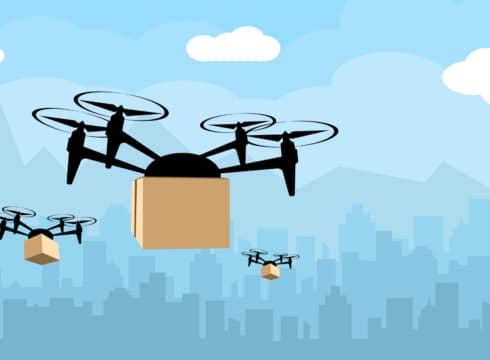India aims to lead Industry Revolution 4.0 by 2030, with drones playing a crucial role
When operating on a 5G network, drones experience ultra-high reliability and low-latency connectivity.
The full potential of drones in India is hindered by several regulatory and technological challenges
Inc42 Daily Brief
Stay Ahead With Daily News & Analysis on India’s Tech & Startup Economy
The global drone market is poised for remarkable growth, with projections indicating a substantial evolution into a $51.4 Bn industry by CY27 and potentially reaching around $91.3 Bn by CY30.
This expansion positions drones as significant disruptors for the future, offering a multitude of benefits across various sectors and presenting novel solutions to existing challenges. India aims to lead Industry Revolution 4.0 by 2030, with drones playing a crucial role.
This initiative is expected to enhance the country’s GDP by 1-1.5% and create over five lakh jobs. Drones are integral to the Industry 4.0 ecosystem, prompting calls for expanding the Production Linked Incentive (PLI) scheme introduced by the government in 2021.
Moreover, the allocation of INR 57 Cr for drone technology and components under the production-linked incentive (PLI) scheme in the interim budget 2024 is bound to give India the much-needed impetus to compete on the global stage.
This marks drones as a sunrise sector in India shaping the future of the country in several areas through innovation and technology advancements. Here is how the drone industry and its evolution in India will bring in a lot of positive influence across sectors:
Sustainability: A Priority
Drone technology holds immense promise for environmental conservation and sustainable practices in India. In agriculture, drones enable precision farming techniques, reducing the need for excessive pesticide and fertiliser use by delivering targeted applications.
This not only enhances crop yield but also minimises environmental pollution, showcasing the potential for drones to revolutionise traditional farming practices.
Wildlife Monitoring And Conservation Efforts
Drones play a crucial role in wildlife monitoring and conservation efforts in the country. By providing researchers with the ability to gather data without disturbing ecosystems, drones contribute to more effective conservation strategies.
In disaster response and management, drones facilitate swift and efficient surveying of affected areas, enabling rapid and targeted relief efforts. Their ability to minimise the need for human presence in hazardous environments enhances worker safety and enables more effective emergency response operations.
Challenges Along the Way
The full potential of drones in India is hindered by several regulatory and technological challenges.
These include issues related to airspace management, payload capacity, battery technology, reliability, durability, obstacle avoidance, sensor integration, remote identification, tracking, data security, and privacy.
Addressing these challenges is crucial to unlocking the transformative power of drone technology in India and realising its vast array of potential applications.
Emerging Solutions And Future Scenarios
Despite the challenges, innovative solutions are emerging to pave the way forward for the Indian drone ecosystem.
Envisioning a future where drones play a pivotal role in everyday life, scenarios such as drone delivery of morning coffee, healthcare drones providing prescription medications to elderly parents, and drones transporting emergency supplies during natural disasters are becoming increasingly feasible.
Integrated “droneports” in cities of the future are set to revolutionise logistics, agriculture, healthcare, and other industries, fostering enhanced connectivity, efficiency, and resilience within our societies.
The Impact Of 5G Technology On Drones
5G technology significantly enhances the capabilities of autonomous drones. Traditionally, drones rely on less dependable point-to-point links, which may lose signal intermittently during flight.
However, when operating on a 5G network, drones experience ultra-high reliability and low-latency connectivity. Consequently, drones can promptly receive and execute commands from the ground control system or pilot. It also reduces the time between sending, receiving, and acting upon commands and minimises the potential for errors during flight.
The Future Of Drones In India And Beyond
In the fast-evolving landscape of drone technology, India stands as a burgeoning hub for enthusiasts and industry players alike. With a rich history of innovation and creativity in drone development, the Indian drone industry is poised to capitalise on emerging trends and technological advancements.
From the early days of unmanned aerial vehicles inspired by visionary inventors to the present-day revolution in aerial systems, the Indian drone industry reflects a persistent quest for innovation and a commitment to shaping the future of aviation.
As we continue to witness the evolution of drone technology, fueled by advancements in artificial intelligence, robotics, and other cutting-edge fields, the possibilities for drones in India are endless.
With the right regulatory frameworks, technological innovations, and strategic collaborations, drones have the potential to revolutionise industries, transform lives, and shape the future of aviation in India and beyond.
{{#name}}{{name}}{{/name}}{{^name}}-{{/name}}
{{#description}}{{description}}...{{/description}}{{^description}}-{{/description}}
Note: We at Inc42 take our ethics very seriously. More information about it can be found here.


